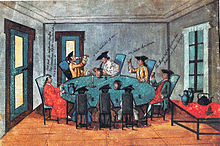Banyan (garment)

The American merchant and philanthropist Ward Nicholas Boylston in a bright green banyan with a hat, painting by John Singleton Copley , 1767.

Student hospice in Jena, library painting around 1750: The host on the left wears a dressing gown as a sign of his dignity.
A banyan (from Portuguese banian and Arabic بنيان, banyān , from Gujarati વાણિયો, vāṇiyo , meaning 'trader') is a piece of clothing that was worn by men in the 18th century and shows an influence of Persian and Asian forms of clothing.
In Pakistani and Indian English today the term is used to mean undershirt.
Even as a dressing gown , dressing gown or robe de chambre called, the Banyan was a wide, T-shaped or kimono -like cut coat made of cotton , linen or silk . It was worn around the house as a kind of informal coat over a shirt and breeches . Instead of the formal wig , a soft, turban-like hat was worn to the banyan .
Web links
Commons : Banyan - collection of images, videos and audio files